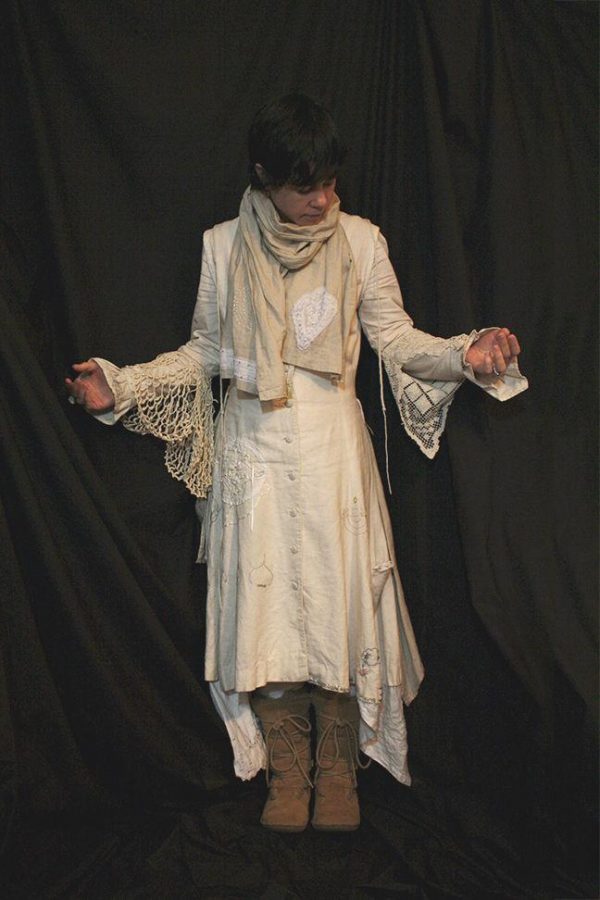‘Gatherings’ explores common peace in worship and art
November 24, 2014
In January 2011, a woman clad in an asymmetrical patchwork dress approached the Agape Christian Fellowship Church of Pittsburgh in Larimer County. Adjusting her scarf, she entered the church and stayed for the service.
Once the ceremony was over, the woman drove back to her studio. There, she added more textile puzzle pieces to her dress, because she was inspired by what she observed at the service.
In the following weeks, she repeated this ritual, visiting the Shaare Torah Congregation in Squirrel Hill and Scientology Pittsburgh in South Side. These are only three of the 100 religious ceremonies that she attended, which prominently included Presbyterian, Roman Catholic, Episcopal and Orthodox Jewish.
This is all part of “Gatherings,” the 13-month art project with which soon-to-be Pitt professor of studio art Becky Slemmons challenged herself.
From August 2010 through September 2011, Slemmons visited 100 places of worship in Pittsburgh and documented her experiences. “Gatherings” culminated in a multi-media art exhibit at 707 Penn Gallery in Downtown. The exhibit opened last Friday and runs through Dec. 31.
Slemmons began by wearing a simple white dress to a service at the Pittsburgh Church of the Brethren. She then sketched drawings inspired by the ceremony. Once the ceremony ended, she returned to her art studio and added details to the dress, influenced by what she experienced at the service.
She repeated this ritual for 99 other religious places of worship in Pittsburgh.
Slemmons also documented her project by snapping 48 self-portraits wearing the dress. Using a video camera, she stitched together a short film of her leaving and returning to her house in the dress, with her dog Zoe always happy to greet her.
Slemmons was surrounded by religion and inspired by art at a young age. Her mother was a part of the Church of the Brethren, and Slemmons grew up attending a Presbyterian Church in Columbus, Ohio, on a weekly basis.
“There was no such thing as not going on Sundays,” Slemmons said.
At the same time, Slemmons knew she wanted to be an artist. She eventually went on to art school as an undergraduate and then studied medical illustration for her graduate degree in 2008.
The next year in June 2009, Slemmons moved to Pittsburgh with her husband. She was intrigued by the variety of religious sites the city had to offer.
Pittsburgh, which Pitt’s own Paula Kane, an associate professor within the Department of Religious Studies characterizes as “a more traditional religious town than many other towns of its size,” was the ideal place for Slemmons to develop and present “Gatherings.”
“I kept driving by all these amazing buildings,” Slemmons said. “So I got really curious.”
Slemmons decided to entertain her curiosity by embarking on “Gatherings.”
“Gatherings” was an ambitious project, and it certainly put Slemmons, a woman who describes herself as adventurous, outside of her comfort zone.
“I wasn’t sure I would like it, because you’re definitely entering a place where you’re not a part. But you can be the outsider and not know a lot of things, so there’s a freedom in that too,” Slemmons said.
“Gatherings” was curated by Murray Horne of the Wood Street Galleries. Horne allowed Slemmons’ artistic freedom to arrange her exhibit — he simply supplied her with 707 Gallery’s intimate space.
“I thought the piece would fit inside the gallery in a very harmonious way, which I think has happened,” Horne said.
The piece fit so well into the gallery that it led one visitor, a woman whom Slemmons met at a synagogue during the project, to comment that “the space itself is gathering us together.”
“What’s interesting to me about ‘Gatherings’ is that it’s a terrific example of process,” Horne said.
The full process of Slemmons’ work is evident in her exhibit, from her visits to worship sites to the evolution of her dress. Her work is recorded in a meticulously detailed step-by-step process.
“She starts from nothing, and after 13 months, you get a really interesting sociological perspective of the current population of Pittsburgh,” Horne said.
Slemmons is very much a person who believes in approaching life from multiple perspectives. Through this exhibit, she encouraged people “to think about what it would be like to be open to experiencing things that you haven’t experienced before.”
She also found a similar peace among religious beliefs and wanted to explore the relationship between the rituals of making art and attending services.
“You leave the rest of the world behind you … in a different place that’s a little bit removed. I feel like you do that when you go worship,” Slemmons said. “You have to get rid of a certain thing, or process it and find peace with it. It’s so similar to when you go into a studio to work.”
Slemmons elaborated on this point, adding that both attending services and making art are meditative processes.
Both religious ceremonies and the ceremony of art-making, Kane said, are rooted in the process of creation.
“All [religions have] been art creators. If the religion has a principle of creation, then they’re usually making art to honor that creative process,” Kane said. “The artist gets to steal a little bit of that creative energy of the Creator. So an artist assumes a fair amount of godlike ability to make things.”








